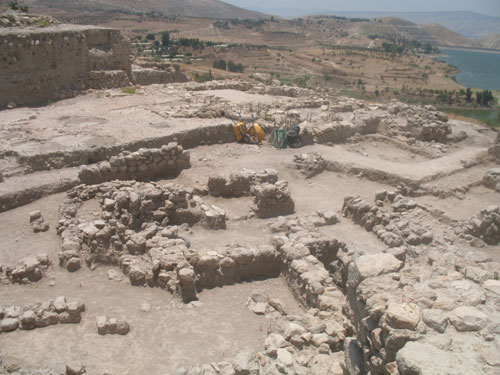2011 - Campaign Summer
Excavations on Tall Zar‘a
The three-week excavation was focused on Area I in the north-west and Area II in the north of the tell. Parallel to the excavation was the third and last part of the field survey in the Wadi al-‘Arab carried out.
Area I
Excavations in Area I started in 2003 with the aim of investigating the stratigraphy of the tell, the nature of the various settlements’ defences (this is a vulnerable slope) and in particular the structure of the residential areas and their workshop installations. Looking counter-chronologically, it is clear that the tell was settled virtually continuously from the Umayyad period back to the middle Early Bronze Age.
In the centre of AreaI the excavation explored the Level of Early Bronze Age III with a well-constructed domestic building.
In the northern part of Area I two different Middle/Late Bronze Age occupation levels near the large Late Bronze Age building with a pebble paved courtyard were exposed. The connection between the city walls and the Late Bronze Age buildings were proved.

Summer 2011 - Area I, northern part
Area II
Excavations in Area II began in 2006 and were continued each year with a break in 2010. The aim is to excavate administrative or other important buildings which have been assumed in this naturally well protected part of the tell.
The aim of the excavations in Area II was the investigation of the occupation from the Umayyad to the Hellenistic period. The focus of the work during the summer campaign 2011 was the clarification of the latest occupation in Area II which can be dated to the Umayyad and Late Byzantine period. The ground planes of different rooms were completed. These rooms and larger architectural complexes were built against an older building of the Early Byzantine period. The houses of the Byzantine period were also used during the Umayyad period and were repaired in many cases. The architecture of the Umayyad period is recognizable by a special building technique of binder and stretcher.
In the southern part of the excavation area some uncovered walls extend our knowledge about the earlier occupation phases of the Roman and Hellenistic period which differs completely from the later building structure. However, these remains are very disturbed by the heavy building activities during the Byzantine period.
Survey in the Wadi al-‘Arab
The survey is an integral part of the “Gadara Region Project”. During the third season the hinterland of the Tall Zar‘a was completely examined. At the very heart of such an exploration are the questions of settlement pattern, distribution, relation and relative importance through time. With the knowledge of the previous surveys we are now able to map 201 sites and installations.
In this year the close inspection of the hinterland of the Tall Zar’a (zone A) was enhanced with a broad view on the Wadi al-‘Arab region by revisiting the major sites in the whole area (zone B). The exact location of all sites was measured by GPS, pottery was collected for comparison and descriptions of the current state were refreshed.
Despite the continuing demolition of the ancient sites, we could discover a representative amount of pottery from all sites, from which can derive a concise overview of the history of the Wadi al-‘Arab.
Documentation and examination of finds
Like every year during the summer campaign, the examination of the finds was also an important task. Two ceramic specialists worked on their material for completing their PD thesis next year.
Outlook
After the summer campaign 2011 we are prepared to publish the results of the excavations on Tall Zar‘a (15 field seasons form 2003 to 2011), of the tell survey (2001) and the field survey in Wadi al-‘Arab (three seasons from 2009-2011) during the next years. The continuation of the field work is planned for 2015.
Acknowledgements
Our thanks go to all of the very generous institutions and individuals who support our work: the Department of Antiquities of Jordan for issuing the permits for our work and also the Friends of the BAI Wuppertal, the GPIA Jerusalem/Amman and the Gerda-Henkel-Stiftung, Düsseldorf, for their long-term and consistent facilitation of our very successful work in the “Gadara Region Project”.
Last updated: 2011
|
CURRENT NOTE (2017) The results of the excavation campaigns from 2003 to 2011 are represented in detail in the final publication. |
|
Project Partners |
|
Biblical Archaeological Institute Wuppertal (BAI) |
|
Patronage |
|
His Royal Highness Prince El Hassan bin Talal took up the patronage of this project as a representative of the royal house. |
Friends and Donors |
|
Cooperations |
|
We cooperate closely with many universities, institutes and companies.  |

 print version
print version
